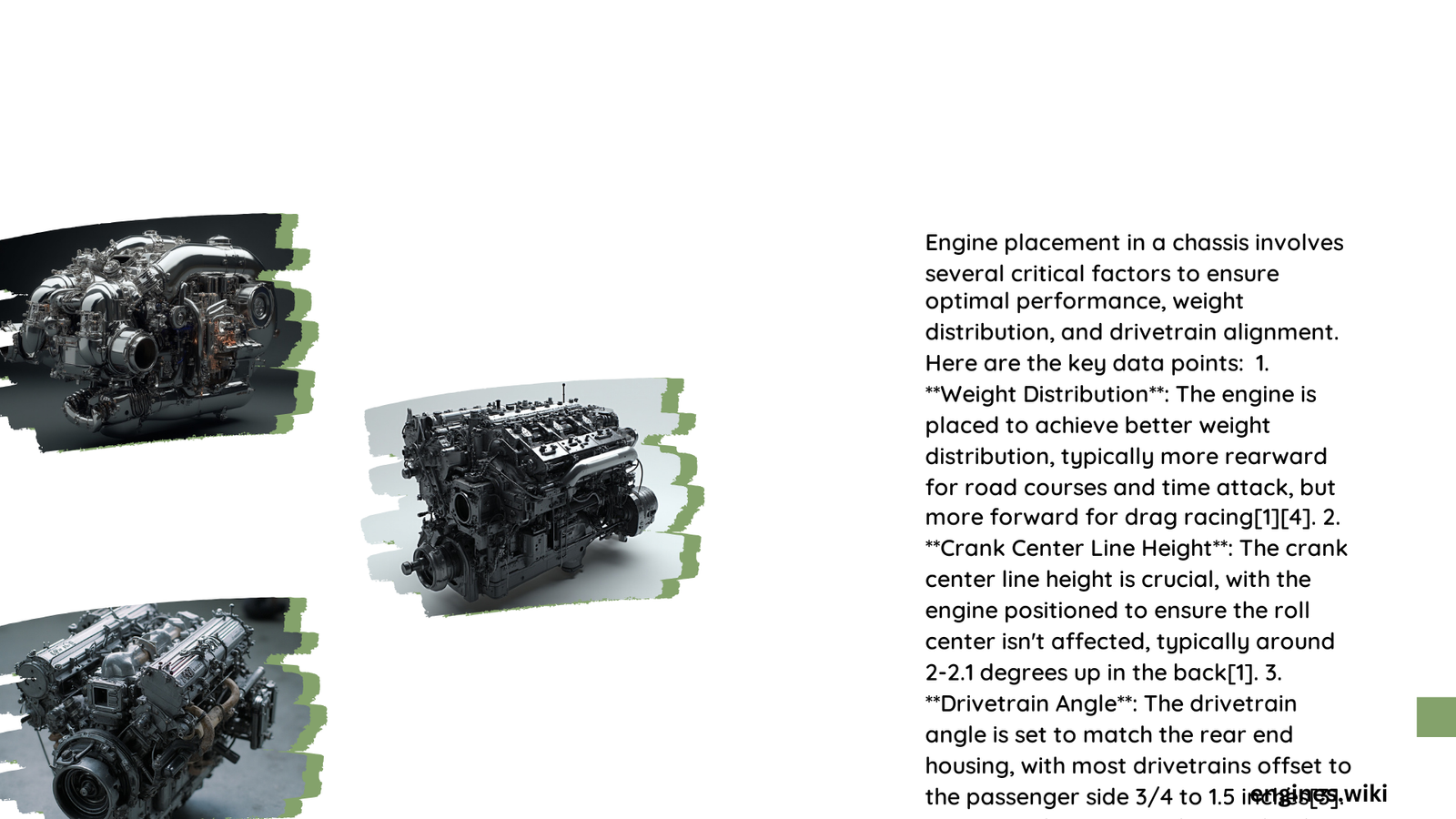Engine placement in chassis is a critical aspect of vehicle design that significantly impacts performance, handling, and overall driving dynamics. Proper engine positioning within the chassis framework involves precise calculations, consideration of weight distribution, and careful alignment techniques. This article explores the intricacies of engine placement, its effects on vehicle characteristics, and best practices for optimal integration.
What Are the Key Factors in Engine Placement?
Engine placement in chassis involves several crucial factors:
- Weight distribution
- Center of gravity
- Chassis design
- Engine mounting locations
- Vehicle dynamics
Let’s delve into each of these aspects to understand their importance in engine placement.
How Does Weight Distribution Affect Engine Placement?

Weight distribution is paramount in engine placement. It directly influences:
- Vehicle handling
- Traction
- Acceleration
- Braking performance
Ideally, a 50/50 weight distribution between the front and rear axles is desired for balanced handling. However, this is often challenging to achieve, especially with front-engine configurations.
Front-Engine Placement
Front-engine placement is the most common configuration in passenger vehicles. It offers several advantages:
- Easy maintenance access
- Simplified drivetrain layout
- Better protection in frontal collisions
However, it can lead to a front-heavy weight distribution, potentially causing:
- Understeer
- Increased tire wear on the front wheels
- Reduced traction on rear-wheel-drive vehicles
Mid-Engine Placement
Mid-engine placement positions the engine between the front and rear axles. This configuration offers:
- Near-perfect weight distribution
- Lower center of gravity
- Improved handling and cornering abilities
Challenges of mid-engine placement include:
- Limited interior space
- More complex maintenance procedures
- Potentially higher production costs
Rear-Engine Placement
Rear-engine placement, while less common, offers unique characteristics:
- Excellent traction for rear-wheel-drive vehicles
- Compact drivetrain layout
- Unique handling characteristics (prone to oversteer)
Drawbacks include:
- Potential for unstable handling at the limit
- Reduced front-end crash protection
- Limited front trunk space
What Role Does Center of Gravity Play in Engine Placement?
The center of gravity (CG) is crucial in engine placement considerations. A lower CG generally results in:
- Improved handling
- Reduced body roll
- Enhanced stability
Engine placement significantly affects the vehicle’s CG. Here’s a comparison of different engine placements and their impact on CG:
| Engine Placement | CG Height | Handling Characteristics |
|---|---|---|
| Front | Medium | Balanced, tendency to understeer |
| Mid | Low | Agile, neutral handling |
| Rear | Medium-High | Responsive, tendency to oversteer |
How Does Chassis Design Influence Engine Placement?
Chassis design and engine placement are interdependent. Key considerations include:
- Structural integrity
- Crash safety
- Packaging efficiency
- Aerodynamics
Structural Integrity
The chassis must be designed to:
- Support the engine’s weight
- Withstand torsional and bending forces
- Minimize vibration transmission
Crash Safety
Engine placement affects crash safety:
- Front-engine: Provides a crumple zone in frontal collisions
- Mid-engine: Offers better side-impact protection
- Rear-engine: Requires careful design to manage rear-end collisions
Packaging Efficiency
Efficient packaging is crucial for:
- Maximizing interior space
- Optimizing weight distribution
- Ensuring proper cooling and airflow
Aerodynamics
Engine placement influences the vehicle’s aerodynamic profile:
- Front-engine: Traditional hood shape, easier to manage airflow
- Mid-engine: Allows for sleeker front-end design
- Rear-engine: Enables unique aerodynamic solutions (e.g., Porsche 911)
What Are the Best Practices for Engine Mounting?
Proper engine mounting is critical for optimal performance and longevity. Best practices include:
- Use of high-quality, durable mounts
- Precise alignment of mounting points
- Consideration of engine torque and vibration
- Proper load distribution across mounts
Engine Mount Types
Common engine mount types include:
- Elastomeric mounts
- Hydraulic mounts
- Active mounts
Each type offers different levels of vibration isolation and performance characteristics.
How to Calculate Optimal Engine Placement?
Calculating optimal engine placement involves several steps:
- Determine the desired weight distribution
- Calculate the center of gravity
- Assess the impact on vehicle dynamics
- Consider packaging constraints
Weight Distribution Calculation
To calculate weight distribution:
- Measure the weight on each axle
- Divide the front axle weight by the total weight for front weight percentage
- Repeat for the rear axle
Example:
– Total vehicle weight: 3000 lbs
– Front axle weight: 1650 lbs
– Rear axle weight: 1350 lbs
Front weight distribution: (1650 / 3000) * 100 = 55%
Rear weight distribution: (1350 / 3000) * 100 = 45%
What Challenges Arise in Engine Placement and Alignment?
Several challenges can arise during engine placement and alignment:
- Balancing performance with practicality
- Managing heat dissipation
- Ensuring proper drivetrain alignment
- Accommodating ancillary components (e.g., exhaust, intake)
- Meeting safety regulations
Heat Management
Proper heat management is crucial. Considerations include:
- Adequate airflow for cooling
- Strategic placement of heat shields
- Efficient exhaust routing
Drivetrain Alignment
Precise drivetrain alignment is essential for:
- Minimizing vibration
- Reducing wear on components
- Optimizing power transfer efficiency
Conclusion
Engine placement in chassis is a complex but crucial aspect of vehicle design. It requires careful consideration of weight distribution, center of gravity, chassis design, and numerous other factors. By optimizing engine placement, manufacturers can achieve the desired balance of performance, handling, and practicality in their vehicles.
